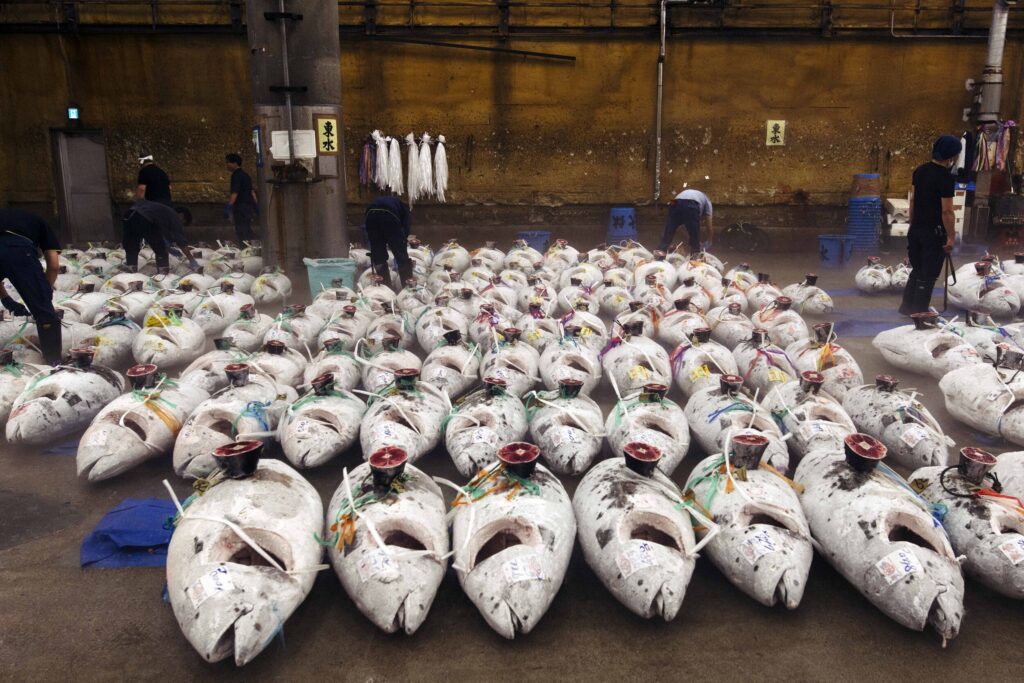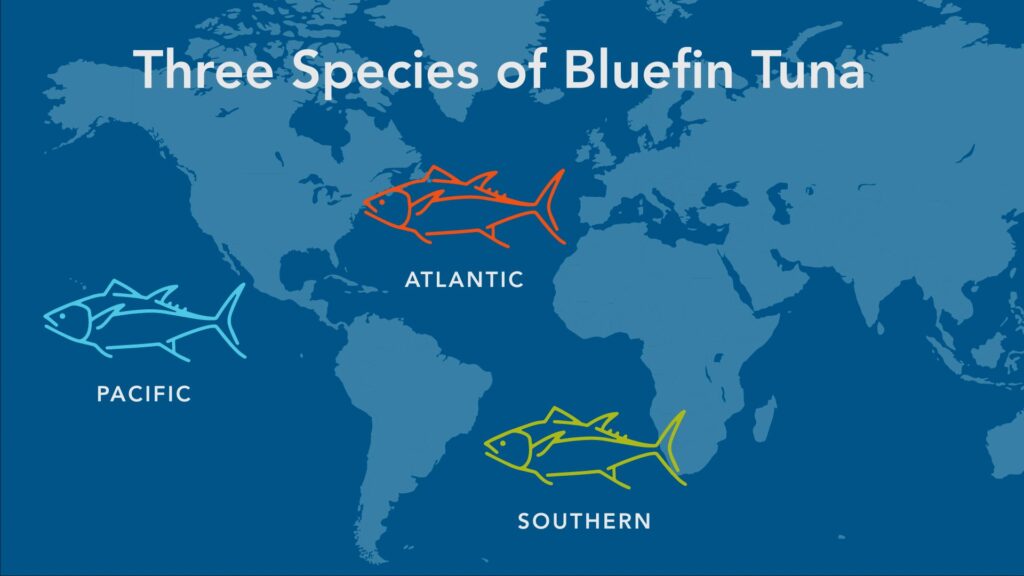Why Bluefin Tuna Is the World’s Most Expensive Fish: A Deep Dive Into the High-Value Market
The bluefin tuna, particularly the Pacific and Atlantic species, has become synonymous with luxury dining. Known for its rich taste and melt-in-your-mouth texture, it is a prized delicacy in high-end restaurants around the globe, particularly in Japan, where it is the centerpiece of sushi and sashimi dishes. The demand for bluefin tuna has skyrocketed in recent years, leading to a record-breaking price of $3.1 million for a single fish at a Tokyo auction in 2019.
This blog will analyze how the bluefin tuna became the world’s most expensive fish, exploring its biological features, market demand, fishing practices, conservation efforts, and the economic dynamics that drive its price. We’ll also look into the cultural significance of bluefin tuna, particularly in Japan, and how global regulations are shaping its future.

I. The Biological Characteristics of Bluefin Tuna
A. A Remarkable Species
- Size and Speed
Bluefin tuna are one of the largest and fastest fish in the ocean, growing up to 10 feet in length and weighing as much as 1,500 pounds. Their incredible speed, reaching up to 40 miles per hour, and their ability to regulate their body temperature make them efficient hunters in cold waters, setting them apart from other fish species.
- Rich, Fatty Meat
What makes bluefin tuna particularly desirable for culinary purposes is its high-fat content. The rich marbling of fat throughout the fish, especially in the belly (known as otoro), is prized for its delicate flavor and smooth texture. This makes bluefin tuna the go-to fish for sushi chefs and is a key reason behind its steep market price.
II. Market Demand: The Role of Japanese Cuisine
A. Sushi and Sashimi Culture in Japan
- The Rise of Sushi and Globalization
Sushi has a long-standing cultural history in Japan, but it wasn’t until the 1980s that bluefin tuna became a staple in high-end sushi establishments. Traditionally, tuna wasn’t considered a premium fish, but as sushi chefs began experimenting with fatty cuts like otoro, its popularity surged. With the globalization of sushi in the 1990s and early 2000s, the demand for bluefin tuna expanded internationally, driving prices to new heights.
- Japan’s Insatiable Appetite for Bluefin Tuna
Japan accounts for more than 80% of the global consumption of bluefin tuna, and it is a key driver of the high prices. The New Year’s auction at Tokyo’s Toyosu Fish Market, where buyers compete for the year’s first bluefin tuna, is a cultural phenomenon. The auction price often sets the tone for the market, and record-breaking prices are seen as symbolic of good luck and prosperity for the coming year.
B. The Growth of Global Sushi Culture
- International Demand
While Japan remains the largest consumer of bluefin tuna, the rise of sushi culture in Western countries, particularly the United States and Europe, has further increased demand. High-end restaurants in cities like New York, London, and Paris are willing to pay top dollar for premium cuts, driving competition and prices.
- The Prestige Factor
Owning and serving bluefin tuna has become a status symbol for chefs and restaurateurs. High-end sushi restaurants often market their dishes based on the source and quality of their tuna, further reinforcing its luxury status.
III. Fishing Practices: Supply and Scarcity

A. Overfishing and Stock Depletion
- Unregulated Fishing Practices
The rapid rise in demand for bluefin tuna has led to widespread overfishing, causing populations of the Atlantic, Pacific, and Southern bluefin tuna to plummet. In the early 2000s, it was estimated that Atlantic bluefin tuna populations had declined by as much as 85%. As supply dwindled, prices skyrocketed.
- Illegal Fishing and Black Markets
Despite international regulations, illegal fishing operations targeting bluefin tuna continue to be a significant issue. The high value of bluefin tuna has incentivized black markets, further exacerbating the overfishing problem and putting immense pressure on bluefin populations.
B. Sustainable Fishing Initiatives
- Fishing Quotas and Regulations
To combat overfishing, international organizations like the International Commission for the Conservation of Atlantic Tunas (ICCAT) have implemented strict quotas and regulations aimed at curbing the depletion of bluefin stocks. While these measures have led to some recovery in populations, they have also limited the supply, contributing to the high market prices.
- Aquaculture Efforts: Tuna Farming
Tuna farming, or ranching, has emerged as a potential solution to the overfishing crisis. However, farming bluefin tuna is notoriously difficult due to the species’ size and migratory nature. While some progress has been made, with several farms in Japan and Spain, the process is expensive and time-consuming, leading to only a marginal reduction in overall market prices.
IV. The Economic Dynamics of Bluefin Tuna
A. The Auction System and Price Speculation
- High-Stakes Auctions in Japan
The traditional auction system in Tokyo plays a crucial role in setting the market price for bluefin tuna. The New Year’s auction, in particular, is often driven by symbolic bids rather than market value. In 2019, for instance, a 612-pound bluefin tuna was sold for a record $3.1 million, more than double the previous record. This is largely attributed to the prestige associated with being the top buyer at this high-profile event, which can boost a restaurant’s reputation.
- Price Speculation in Western Markets
In Western markets, the rarity and high demand for bluefin tuna have made it a speculative commodity. High-end restaurants are willing to pay premium prices to secure limited quantities, further inflating its value. This has also given rise to tuna brokers, who specialize in procuring the best cuts of bluefin tuna for their elite clientele.
B. Supply Chain Complexity
- From Ocean to Plate
The journey of bluefin tuna from the ocean to a sushi plate is a complex, multi-stage process. After being caught, the fish is often flash-frozen to preserve its quality. It is then transported via air freight to markets like Toyosu in Tokyo, where it is auctioned off. The fish may then be shipped internationally to high-end restaurants. Each step in this process adds to the final price paid by consumers.
- Luxury Markup in Restaurants
Restaurants often mark up the price of bluefin tuna significantly, especially for prized cuts like otoro. A single piece of sushi made from bluefin tuna belly can cost upwards of $50 in high-end sushi bars in cities like Tokyo or New York. This luxury markup adds to the perception of bluefin tuna as the world’s most expensive fish.
V. Conservation and the Future of Bluefin Tuna
A. Environmental Concerns and Public Backlash
- Endangered Status
The overfishing of bluefin tuna has placed the species on the brink of extinction, with both Atlantic and Pacific bluefin tuna being classified as endangered by the International Union for Conservation of Nature (IUCN). Environmental groups have raised alarms about the unsustainable fishing practices that threaten the future of this iconic species.
- Public Awareness Campaigns
Conservationists and environmental organizations have launched public campaigns to raise awareness about the plight of bluefin tuna. These efforts have led to a growing movement to boycott bluefin tuna in restaurants, particularly in the West, where consumers are becoming more eco-conscious.
B. Sustainable Alternatives
- Farming Innovations
Efforts to farm bluefin tuna sustainably are ongoing. Japan has invested heavily in research aimed at improving tuna farming techniques, with the goal of reducing the pressure on wild populations. However, significant challenges remain, and it will likely be many years before farmed bluefin can satisfy global demand.
- Consumer Shifts Toward Other Fish
As awareness of the environmental issues surrounding bluefin tuna grows, some consumers are turning to alternative fish species like yellowfin or albacore tuna, which are considered more sustainable. Chefs are also experimenting with alternative seafood to replicate the rich flavor and texture of bluefin tuna.
Conclusion: The Future of the World’s Most Expensive Fish
Bluefin tuna has achieved its status as the world’s most expensive fish due to a combination of biological rarity, intense market demand, cultural significance, and economic speculation. However, the future of this species is uncertain. Overfishing, illegal fishing practices, and unsustainable market demand have placed immense pressure on bluefin tuna populations, threatening their long-term viability.
While efforts are being made to introduce sustainable fishing practices and aquaculture, the market for bluefin tuna remains driven by luxury and prestige. Whether future generations will continue to enjoy this prized fish depends on the balance between conservation efforts and consumer demand.
References
- Food and Agriculture Organization (FAO). (2020). “The State of World Fisheries and Aquaculture.”
- International Commission for the Conservation of Atlantic Tunas (ICCAT). (2021). “Conservation Measures and Quotas for Bluefin Tuna.”
- Global Aquaculture Alliance. (2020). “The Challenges and Progress of Bluefin Tuna Farming.”
- Safina, C. (1997). Song for the Blue Ocean: Encounters Along the World’s Coasts and Beneath the Seas. Henry Holt & Co.
- The Guardian. (2019). “Record-Breaking $3.1 Million Bluefin Tuna Sold at Tokyo Auction.”
- National Geographic. (2017). “The Global Sushi Boom and the Bluefin Tuna Crisis.”
- Greenpeace. (2021). “The Endangered Bluefin Tuna and What Needs to Be Done.”






